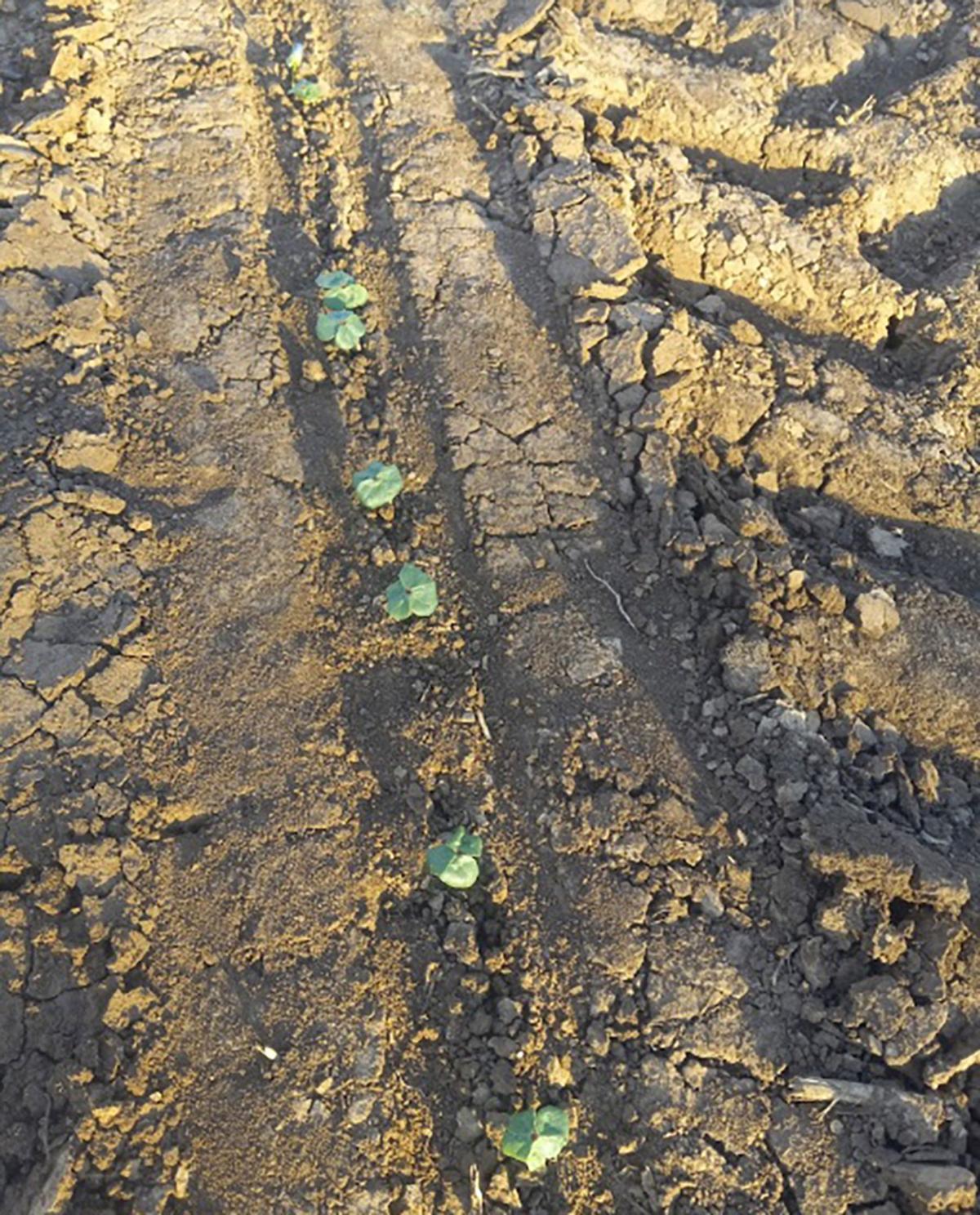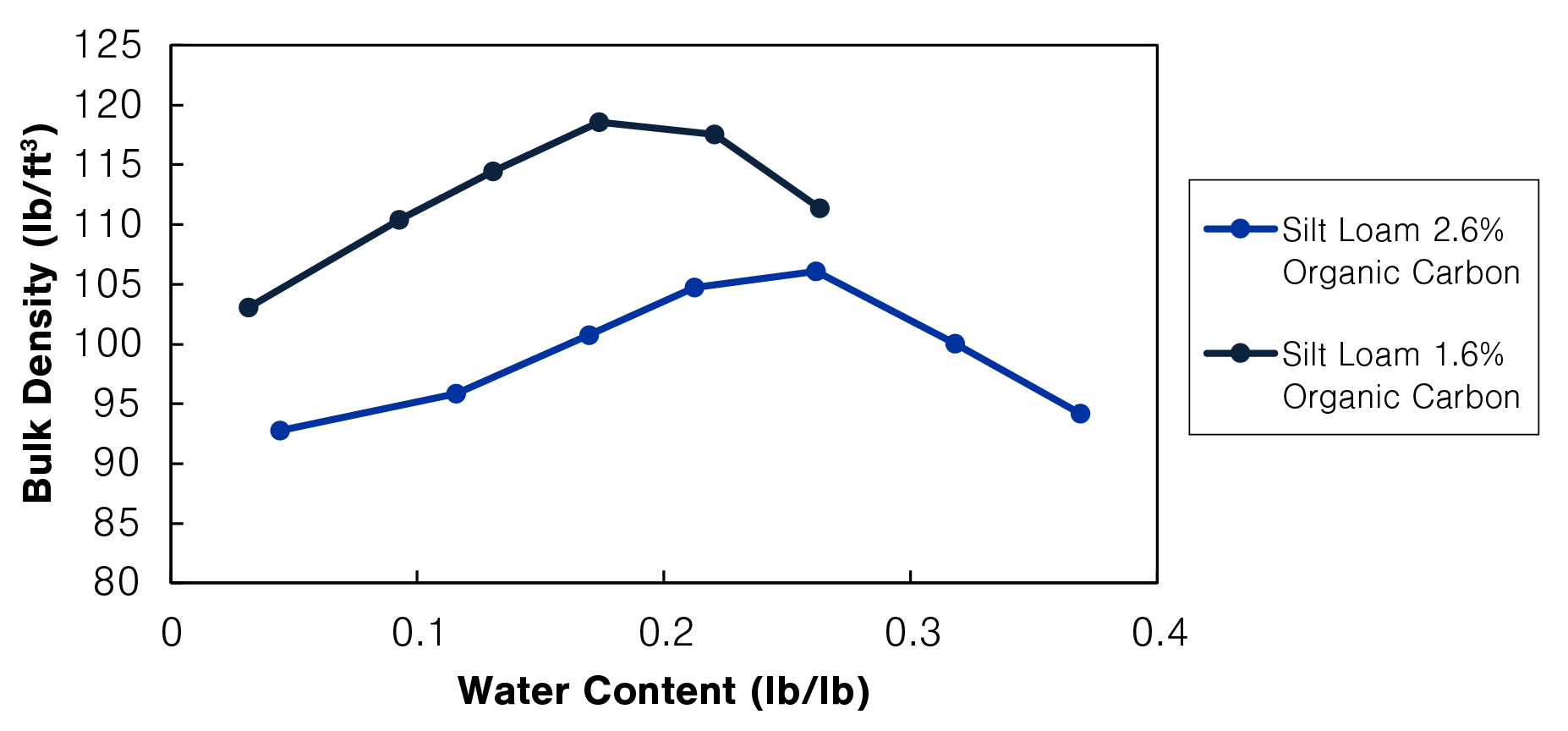Accounting for soil wetness prior to conducting farm operations to minimize compaction

In the spring many agricultural producers are anxious to get into the field and perform tillage, planting, and chemical applications. However, if field operations are done when the soil is too wet, this can lead to soil compaction. Soil compaction can occur from agricultural equipment, animals, and raindrop impact.
Although tillage can be used as a management practice, it also creates a compacted area below the tillage implement. Soil compaction from agricultural equipment can be long lasting in the soil and lead to reduced yields, crop emergence, root growth, and water and nutrient uptake of plants (Shaheb et al., 2021). Soil compaction also can reduce infiltration, soil water storage, and biological activity, and also increase erosion and destroy soil aggregates (Shaheb et al.,2021). One review says compaction from agricultural equipment can lead to a 10 to 20% reduction in crop yields (Sonderegger & Pfister 2021).
Force placed on the soil is dependent upon the weight of the equipment and the area the force is placed over. The larger area a load is applied over reduces the force from the load applied on the soil surface. Figure 1 is an example of what a tractor tire and planter does to a tilled soil. Bulk density is the mass of dry soil in a volume of soil. More information on bulk density can be found in the article, Bulk Density is an Indicator of Soil Health.
Soil Compaction Factors
Many people think that soil is more susceptible to compaction when it is wet. However, this is not actually the case. When soil is dry there is friction between soil particles, which will limit how much compaction occurs when a load is driven on top of the soil (Rahmat and Ismail 2018). Air is easily released from the soil when it is dry, but there are strong bonding forces between soil particles, which limits how much soil can become compacted. As the soil becomes wetter, there is increased lubrication between soil particles, and the soil will compact to a denser level (Rahmat and Ismail 2018). Maximum soil compaction will occur (highest bulk density) when the soil is about 80% of saturated water content (Hillel 1998). Air will easily leave the soil when it is at an intermediate water content and water reduces the friction between soil particles. When the soil is wetter, water gets in the way, and air and water are not easily pressed out of the soil. This leads to the soil being compressed to a bulk density that is not as high as when it is at intermediate water contents. Engineers are interested in packing the soil to high bulk density values when constructing roadbeds and other building sites (Rahmat and Ismail 2018). Engineers use a test called the Proctor compaction test to determine how compacted a soil can become at different water contents. The water content where the soil becomes the most compacted is the Proctor optimum water content. The highest bulk density that the soil can become compacted to is called the Proctor maximum bulk density. An example of the Proctor compaction test on two soils is shown in Figure 2.

The soil with less organic carbon has a lower water content where it is most compactable and packed to a higher bulk density. Organic carbon strengthens the soil particles’ attraction to each other and reduces how much the soil can become compacted. Soils that are sandy generally have a lower water content and they will become the most compacted. Soils with a higher clay concentration usually have a higher water content where they will become the most compacted. This has to do with the effects of water content on how strong soil particles of different sizes are held together. Well-graded and poorly sorted coarser soils (sandier) will pack to a higher bulk density than soils that have a lot of the same particle sizes and/or are finer textured. Spherical sand particles will not pack to a high bulk density due to cohesion forces holding the particles close to each other. Soil particles with a variety of shapes and sizes will better fill voids between the different particle sizes when compacted. The stronger attraction of clay particles to each other and the absorption of water into small pores generally limits how much clayey soils can become compacted. The water content where the soil is most susceptible to compaction is usually when the soil is a little drier than field capacity, or where soil changes from a plastic to semisolid state.
Once the soil becomes wetter than the optimum water content, it will not pack to as high of a bulk density. However, the soil is weaker and cannot bear as much weight. When loads are driven on a wet soil, they sink into the soil deeper, because the soil is not as strong. Soil particles do not form as strong of cohesion to each other when soil is wet compared to when it is dry. This will lead to ruts being formed in the field. However, when ruts are formed in the soil, it may not be as badly compacted as a field that is driven on when soil is near the water content where the maximum bulk density occurs. Although sandy soils will pack to a higher bulk density, compaction will have a larger effect on crop yield in finer-textured (clayey) soils. However, some sands can become so packed that physical separation is almost impossible due to friction-locking forces.
Identifying How Wet Soil Is
Determining the percent water content of soil is a difficult task. The best method involves collecting a sample from the field, determining its wet weight, then drying the sample to determine the dry soil weight. Sensors also can be used to estimate the soil water content, but the soil sensors are not cheap and usually need to be installed at one location. The Mesonet at SDState has stations set up throughout the state that can give an estimate of what the soil water content is in parts of South Dakota. Looking at and feeling the soil also can give an estimation on whether the soil is wet or dry. If the soil is lighter in color and soil aggregates break into other smaller aggregates, it is likely that the soil is drier, and there is a lower risk of compaction occurring. If the soil is darker in color and the soil deforms into a ribbon or puddy like substance, the soil is field moist, or wetter, and more compaction or ruts may form from agricultural traffic. If you are worried about compaction occurring in an area, looking at how wet the soil is prior to driving through the area can reduce how much compaction occurs in the field.
Management and Preventing Compaction
Soil compaction can be minimized by using strategic field operations and using practices that can increase how much pore space is in the soil. The best management practice is to do both of these practices together. Reducing the number of trips that go across the field can minimize the compactive effort that goes across the field. Spreading the weight of the load over a larger area can reduce the compactive load that is placed on the soil. Using controlled traffic reduces the percentage of the field that is compacted from loads. Also, most of the compaction occurs from the first tires that go over the soil at a location, so following in the tire tracks of the first piece of equipment crossing the field minimizes the percent of the field that is compacted. Bulk density only increases a little more from later tires that go over the same spot.
Mitigating soil compaction is a lot more difficult to do than causing soil compaction. One agronomic management practice that can be done is to keep cover on the soil surface, reducing rain drop impact on soil surface. However, leaving crop residue on surface does not stop compaction from driving heavy loads on soil at water contents where it is susceptible to compaction. A natural process that can mitigate compaction is freezing and thawing, or wetting and drying. These processes break large soil aggregates into smaller soil aggregates, and pores will form between the structural units. Tillage also will break up large aggregates into smaller aggregates and sometimes encourage more wetting and drying and freezing and thawing of the soil to occur. However, tillage is a temporary fix to combat compaction, and the reduction of compaction from one tillage operation does not prevent future compaction from occurring. Although, deep tillage will break up the soil to a deeper depth. It will temporarily increase infiltration and reduce bulk density, but its effect will only last for a short period of time.
Many of the soil health management practices can help to reduce how much soil compaction occurs. Leaving crop residues in the field and not tilling will increase soil biology, structure formation, infiltration, and soil organic matter. Higher soil organic matter concentration will form stronger soil aggregates and keep and improve void space in the soil. Cover crops provide additional roots going into the soil, creating pores when the roots decompose, and may increase soil organic matter concentration. The additional living roots from the cover crops also help to dry out the soil in the spring and provide root exudates that may help soil structural units stay together. Adding manures to the soil can increase soil organic matter content, which helps to improve soil structure. Managing soils to improve organic matter concentration helps to improve soil structure and reduce soil compactability.
Summary
Soil compaction can have negative effects to crop production and soil health, and it can be caused by agricultural equipment. The soil is most susceptible to compaction at intermediate water contents, but it is weakest at higher water contents. Strategic trafficking or distribution of weight over a larger area and keeping cover on soil surface can prevent compaction from occurring. Agricultural management practices that provide additional cover on the surface and increase soil organic matter can help to mitigate compaction. To maintain healthy soil, combining strategies that minimize how much compaction occurs with practices that can improve soil aggregation is the best practice.
References
- Hillel, D. (1998). Environmental Soil Physics. Academic Press. San Diego, CA, USA.
- Klopp, H. W., Blanco-Canqui, H., Sindelar, M., Jin, V. L., Schmer, M. R., & Ferguson, R. B. (2023). Did cover crop or animal manure ameliorate corn residue removal effects on soil mechanical properties after 10 years?. Journal of Agriculture and Food Research, 14, 100802.
- Rahmat, M. N., & Ismail, N. (2018). Effect of optimum compaction moisture content formulations on the strength and durability of sustainable stabilised materials. Applied Clay Science, 157, 257-266.
- Shaheb, M. R., Venkatesh, R., & Shearer, S. A. (2021). A review on the effect of soil compaction and its management for sustainable crop production. Journal of Biosystems Engineering, 1-23.
- Sonderegger, T., & Pfister, S. (2021). Global assessment of agricultural productivity losses from soil compaction and water erosion. Environmental Science & Technology, 55(18), 12162-12171.
PHOTO: Indentations into tilled soil from a tractor tire and planter (SDSU Extension)


